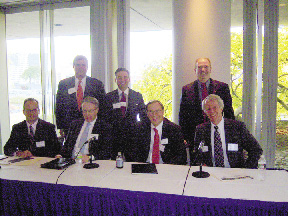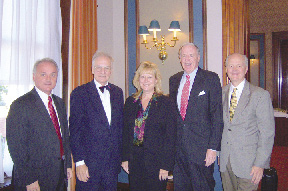The New England/Upstate NY CRE Chapter and the Mass Appraisal Chapter held a joint event on Nov. 9th at Boston's Federal Reserve Bank. Over 40 attendees were present for the program was entitled "Boston's Payment In Lieu of Tax Initiative." Boston is home to many of the nation's finest educational, medical, and cultural institutions. State law exempts these institutions from paying real estate taxes on property used to support their non-profit mission. The cost of providing these tax exemptions falls on the remaining taxpayers in the City. While the benefits offered by the institutions are often well known, their direct benefit to Boston residents is at times less clear.
In 2009 mayor Thomas Menino created the PILOT (Payment in Lieu of Taxes) Task Force to review the current system and make recommendations to create equitable agreements in the future with the goal of strengthening the partnership between Boston and its non-profit institutions and raising revenues for the City. Many institutions make a voluntary payment-in-lieu-of taxes (PILOT) to the City to help cover the cost of providing the institutions with essential City services (i.e. police, fire, snow removal). However, the PILOT contributions vary considerably between the institutions.
The joint program presented compelling findings of the PILOT Task Force with its concluding rationale. The panel discussed the process and deliberations from Committee Members, in-depth perspectives of key thought leaders in urban policy, potential implementation and appraisal strategies from the City of Boston Assessor's office, as well as point and counterpoint from the healthcare and non-profit realm. The panel participants included:
*Moderator: Peter Nichols; CRE principal, NorthStar Ally LLC.
Speakers:
*Stephen Kidder, Esq; Hemenway & Barnes LLP (chair, PILOT Task Force);
*Ronald Rakow, commissioner, Boston Board of Assessors;
*Sam Tyler, president, Boston Municipal Research Bureau; and
*John Erwin, executive director, Conference of Boston Teaching Hospitals.
Peter Nichols welcomed the audience and introduced each panelist and their presentation role. Steve Kidder, the PILOT Task Force Chair set the foundation for the program with a brief history of the PILOT Task Force and its 9 member representation. The Task Force goals were: 1) Set a standard level of contribution to be met by all tax-exempt land owners 2) Develop a methodology for valuing community benefits and 3) If necessary, provide recommendations on legislative changes needed at the city or state level. The Task Force met from Feb. 2009 to April, 2010 and held public hearings. The major tax revenue issue for the City of Boston is that approximately 52% of city property is tax-exempt. Therefore 48% of the remaining taxable land owners contribute 64-65% of towards the city's budget. The recommended PILOT guidelines proposed were as follows:
*PILOT to remain voluntary and not mandated
*PILOT program should be applied to all non-profit groups. Exceptions made for non-profits with property values at less than $15 million
*Determining PILOT payments should be based on value of real estate holdings. Base PILOT should be 25% of what the institution would have paid if it was a commercial institution.
*Importance of community benefits. Non-profits should receive 50% PILOT deductions for community benefits
*What community benefits qualify? Steve indicated that it wasn't an easy answer and wasn't just direct benefits to the city. But services should be quantifiable as a definition of benefits.
*Payments to be phased in with 5 years as a barometer.
*Property tax credit given to institutions for any real estate left on the tax rolls.
Ron Rakow, Boston's Assessing Commissioner, then gave an overview history of the fiscal impact of non-profits and stated that there is a disconnect between benefits and costs associated with non-profits. The property tax reliance was an interesting break-down.
1. Nearly 64% of Boston's revenues are from property taxes
2. There is no other source of tax revenue and that is unique compared to other U.S. cities. Other cities have sales tax, income tax, payroll tax, etc.
3. 52% of the city's land owners are exempt including over 30 universities, over 25 hospitals, over 20 cultural major facilities and the state capital.
4. Proposition 2 ½ limits tax increases to 2.5% for taxable properties
5. The problem is a convergence of a perfect storm
Benefits of Exempt Institutions
1. Education
2. Health care/medical research
3. Cultural institutions
4. Free care for poor and handicapped
5. Serve as economic generators; payroll, etc. but city can't tax.
Taxes that does go to the state result in a fractional percent coming back to cities and is not significant.
6. There is a disconnect between city benefits and the cost. Benefits are spread broadly. Costs are concentrated therefore on Boston taxpayers.
Ron went on to state the "good news/bad news" issue. The good news is that PILOT generates $34 million in revenues which is the most successful in the U.S. The bad news is that the $34 million represents a small fraction of the city's tax total revenues (approximately 1.5% of all collected revenues). So the key questions are as follows:
1. So how much would tax-exempt institutions pay?
2. How does each institution's PILOT compare to taxes on the same properties?
In the Fall of 2007, the City of Boston asked each major educational and medical institutions to provide detailed information on its real estate and found the following:
1. F'09, the educational institutions total tax exempt value was $ 7 billion and 21.5 million square feet. This real estate would have generated approximately $190.2 million in taxes.
2. Medical institutions in F'09 had $5.7 billion of real estate value and 15 million square feet which would have generated $155 million in taxes.
3. Summary: if taxed, education and medical institutions would generate $347.9 million in taxes representing 4.2% of what they would pay if properties were taxable. At 25% payment under PILOT, the tax generation would be $87 million.
Sam Tyler of Boston Municipal Research Bureau asked, "Will the City tax its Non-Profits?" He then laid out the financial landscape of the city. The financial overview for F'11 for the city's collected revenues:
*State Aid = 17%
*Net Property Tax = 64%
*Non-recurring = 2%
*Recurring = 17%
State aid has been decreasing to the city over the last few years.
Revenue Trends F'04-F'11
*State Aid = (14%)
*Excise = 76%
*Property = 42%
*Non-recurring = 147%
*Recurring = 21%
F'11 Spending Distribution
*Discretionary = 32%
*Non-Departments = 0.49%
*Departments = 68%
Select F'04-F'11 Spending Growth
*Health Insurance = 71%
*Pension = 55%
*Other Depts. = 13%
*PHC = 19%
*Police = 28.2%
*Fire = 27.7%
*Schools = 21%
Taxed Area
*Residential 47%
*Business 23%
Of the City's Property Areas, approximately 50% is tax exempt of which 11% of the 50% is privately owned and 39% of the 50% is public. The property areas as a percent of the total properties in the City breakdown as follows:
1.Religious = 4% of the total
2.Benevolent = 2%
3.Library = 3%
4.121A = 1%
5.Public = 39%
6.Other = 1%
7.Taxable = 50%
The PILOT payments made in F'10 equaled $34-35 million of which MassPort contributed $16 million or approximately 48% of the total PILOT payments. A plan was then proposed as follows:
1.It is an appropriate time to review the current process
2.Agreements continue to be voluntary and negotiated
3.Significant increase in PILOT payments are not expected; Maybe have a soft cap on payments
Recommendations offered included:
Critical interest is the information provided by non-profits and how that translates into property valuation and accepted. BIDMC now pays $167,000 and would be paying $2.7 million. Children's Hospital pays $112,000 and the projected payment would be $2.344 million. Significant increases and its phased in amounts over 5 years but it is now still voluntary. Valuation will be difficult on methodology and policy-making.
John Erwin of COBTH then concluded the program with the hospital's perspective of the 14 hospitals that form this unique concentration and include teaching hospitals. He started with the COBTH hospital's generated economic impact of benefits. 1) Payroll and benefits 2) Rent paid on taxable square feet 3) Construction projects at hospitals. The dollar impact in Boston is $3 billion of direct and $2.1 billion of indirect benefits. They employ 77,000 in Massachusetts. Research funding reached $1.3 billion in NIH funding and supplied 25,000 direct and indirect jobs in the region. They have had $2.5 billion of impact on the regional economy and create jobs due to research and research funding. The COBTH PILOT positions are as follows:
1.The program should remain voluntary
2.Focus should include other non-profits
3.Community benefit program-planning must be continued to be guided by community needs assessment required by the AG and IRS.
4.Existing CB programs should count towards offset v. PILOT
5.No cap on the percent of PILOT that may be off-set with CB programs
The Non-Profit hospital community benefits were to include:
1. Guidelines set by the AG to define "benefits"
2. CB plan based on community needs assessment
3. Specified target populations
4. Regular evaluations of programs
5. Annual reporting to AG
The 2009 community benefits reported to AG were as follows:
*$153 million of direct community benefits
*$6.1 million community service
*$83 million of charity care
John stated that the current impact of a new policy on hospitals would be as follows:
*Hospitals now pay $4.9 million under PILOT
*Under the New PILOT with no CB offset = $32 million
*New PILOT with CB offset = $16 million
The operating margins for hospitals are under 10% and any increase in taxes would be harmful to the economic health of these institutions. There are cuts in Medicare as well that happen without any notice and hamper revenues.
The Panel stated that the report is complete and positions are known. The next move is the roll-out of the full report and digestion of that report in the next 2-3 months so that the Mayor can make future policy decisions.
The Chapter would like thank Peter Nichols, CRE for organizing the event and for serving as the moderator.
Tentative 2010 Calendar of Events
*Dec. 15, 2010: Holiday Reception, Algonquin Club, Boston, MA
2010 Chapter Officers
*Robert J. Nahigian, Auburndale Realty Co., Chapter Chair
*Emmet T. Logue, Hunneman Appraisal & Consulting, Vice-Chair
*Robert E. Costello, Capital Crossing Servicing Co., LLC, Secretary/Treasurer
*Jill Hatton, Board Member
*Walter Pennell, Hunneman Appraisal & Consulting, Board Member
*Peter Nichols, NorthStar Ally LLC, Board Member
*John McLaughlin, McLaughlin Co., Board Member











